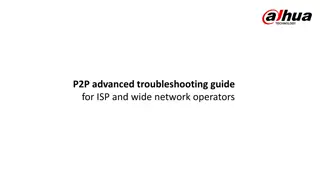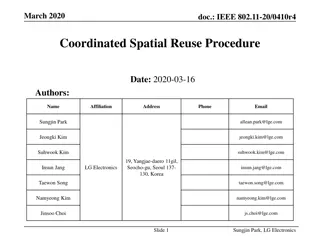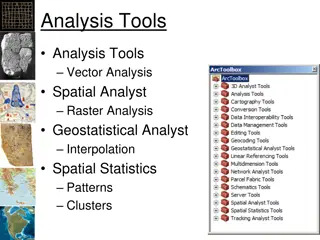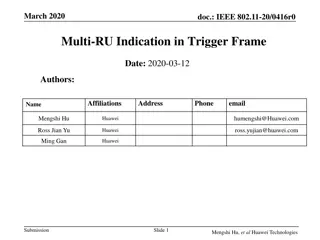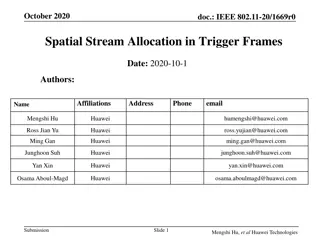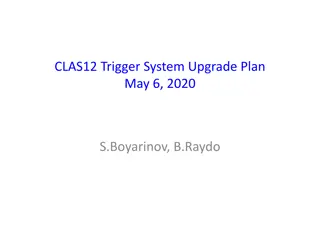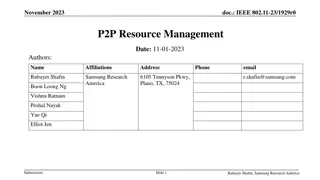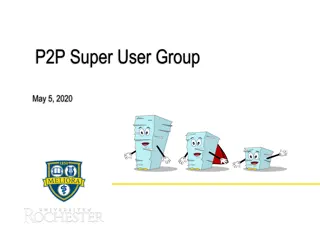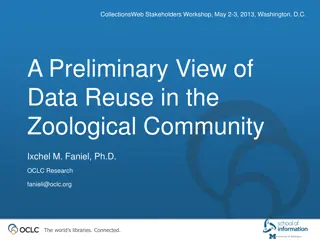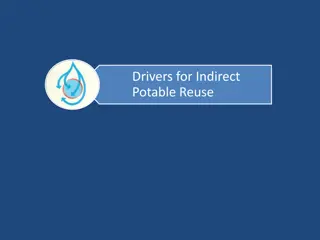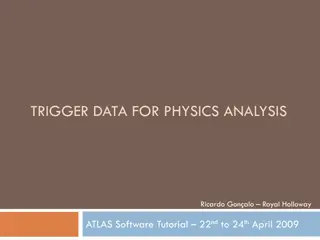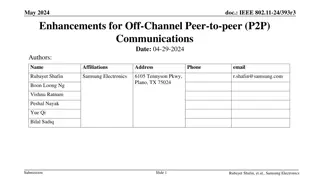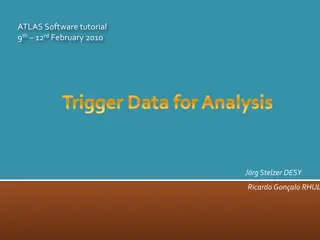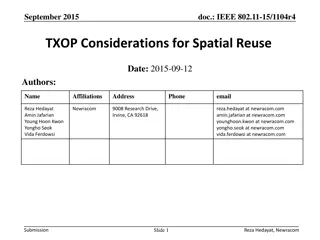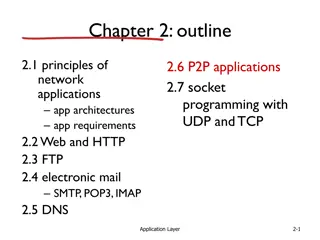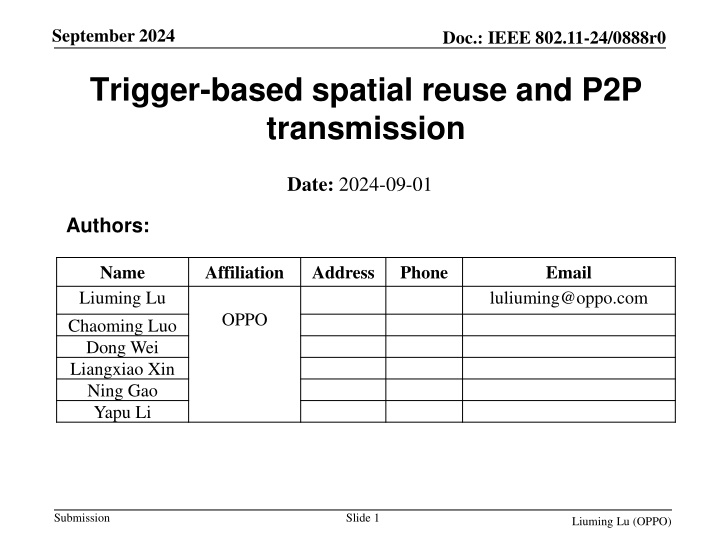
Enhancing Peer-to-Peer Transmission with Coordinated Spatial Reuse in IEEE 802.11-24
Explore the implementation of coordinated spatial reuse for Peer-to-Peer (P2P) scenarios in IEEE 802.11-24 to optimize medium utilization and enhance throughput. Addressing issues such as hidden node problems and inefficient channel protection for improved system performance.
Download Presentation

Please find below an Image/Link to download the presentation.
The content on the website is provided AS IS for your information and personal use only. It may not be sold, licensed, or shared on other websites without obtaining consent from the author. If you encounter any issues during the download, it is possible that the publisher has removed the file from their server.
You are allowed to download the files provided on this website for personal or commercial use, subject to the condition that they are used lawfully. All files are the property of their respective owners.
The content on the website is provided AS IS for your information and personal use only. It may not be sold, licensed, or shared on other websites without obtaining consent from the author.
E N D
Presentation Transcript
September 2024 Doc.: IEEE 802.11-24/0888r0 Trigger-based spatial reuse and P2P transmission Date: 2024-09-01 Authors: Name Liuming Lu Chaoming Luo Dong Wei Liangxiao Xin Ning Gao Yapu Li Affiliation Address Phone Email luliuming@oppo.com OPPO Submission Slide 1 Liuming Lu (OPPO)
September 2024 Doc.: IEEE 802.11-24/0888r0 Introduction UHR takes enhancement of WLAN reliability for both an isolated BSS and overlapping BSSs as a main Objective[1] to improve efficient use of the medium to increase throughput at different SINR levels (Rate-vs-Range) to reduce latency and jitter to improve Peer-to-Peer (P2P) operation IEEE 802.11bn task group has agreed to define multi-AP Coordinated Spatial Reuse (CSR) operation to improve system performance. This contribution analyzes a P2P scenario for trigger-based spatial reuse (or CSR) from the dimensions of increasing throughput and improving efficient use of the medium, and proposes candidate key functions for CSR to be considered . Submission Slide 2 Liuming Lu (OPPO)
September 2024 Doc.: IEEE 802.11-24/0888r0 Recap: HE/EHT SR & EHT TXS HE/EHT spatial reuse 1. OBSS PD-based spatial reuse Type1: allows a STA to ignore inter-BSS PPDUs using a non-spatial reuse group(non-SRG) OBSS PD level. Type2: allows a STA to ignore inter-BSS PPDUs that are identified as being SRG PPDUs, using an SRG OBSS PD level. 2. Parameterized Spatial Reuse PSR -based spatial reuse An HE STA initiates an SR transmission (i.e. transmit an PSRT PPDU) during an PSR opportunity for the duration of an ongoing PPDU (i.e. HE TB PPDU) that is triggered by the Trigger frame of the PSRR PPDU. The transmit power of the PSRT PPDU is limited to avoid interfering with the reception of the ongoing PPDU at the recipient The STA shall not transmit an PSRT PPDU that terminates beyond the PPDU duration of the ongoing PPDU. Figure 1: PSR-based spatial reuse EHT TXOP Sharing (TXS) TXOP sharing with mode2 allows a scheduled STA to transmit PPDU to the AP and to another STA by within the allocated time shared by the AP. Submission Liuming Lu (OPPO) Slide 3
September 2024 Doc.: IEEE 802.11-24/0888r0 Issues PD/PSR-based spatial reuse although PD/PSR-based spatial reuse operation increases the opportunity of the STAs to access the medium, they are not scheduled or coordinated operation. The tools cannot be used to schedule the transmissions among STAs by reusing the medium based on the STAs requirements for the traffic to be delivered. TXOP sharing with mode2 for P2P transmission Hidden node issue would be serious if the distance between a non-AP STA and its P2P peer is relatively shorter than the distance between the non-AP STA and AP. Excessive channel protection would result in inefficient use of the medium for P2P transmission. Submission Slide 4 Liuming Lu (OPPO)
September 2024 Doc.: IEEE 802.11-24/0888r0 Objectives The coordinated spatial reuse is proposed to be introduced in P2P scenario. The main objectives are described as follows: The coordinated spatial reuse operation can be used as a tool to schedule the transmissions among STAs by reusing the medium based on the STAs requirements for the traffic to be delivered. The SR transmission should not interfere with the reception of the ongoing PPDU at the recipient for another transmission. The appropriate STAs for SR transmission need to be selected based on the distribution of the STAs and the intended transmit power for the STAs. The coordinated spatial reuse operation should be helpful for increasing aggregate throughput of the system and/or reducing the latency and jitter for the delivery of the traffic. Submission Slide 5 Liuming Lu (OPPO)
September 2024 Doc.: IEEE 802.11-24/0888r0 Scenarios to be considered Use of WLAN P2P communications is increasing in a wide range of deployment scenarios, which are competing with infrastructure WLAN usage for the same medium resources. This requires better coordination between neighboring APs and between P2P networks [4] Edge server AP HMD HMD PC Mobile Device Mobile Device The distance between the mobile device and HMD is relatively shorter than the distance between the mobile and AP or the distance between the PC and AP. The transmission between the mobile and HMD have no/little interference with the reception of the ongoing PPDU at the AP for the transmission between the PC/another mobile and AP if appropriate PC/mobiles are selected for the transmission. Submission Slide 6 Liuming Lu (OPPO)
September 2024 Doc.: IEEE 802.11-24/0888r0 An example for trigger-based spatial reuse AP obtains an TXOP and sends a trigger frame(TBD) for CSR: The trigger frame allocates resources for and solicits one TB PPDU transmission to PC. simultaneously the trigger frame allocates/shares some of resources for one or more PPDUs to HMD Targets: 1. the P2P transmission should not interfere with the reception of ongoing TB PPDU at the recipient. 2. to increase aggregate throughput of the system and/or reduce the latency and jitter for the delivery of the traffic 20MHz MU MU- -RTS RTS Trigger(*) Trigger(*) CTS CTS- -to self self to- - BA BA 20MHz MU MU- -RTS RTS Trigger(*) Trigger(*) AP AP 20MHz CTS CTS TB PPDU TB PPDU 20MHz CTS CTS PC PC 20MHz CTS CTS PPDU PPDU Mobile Mobile ACK ACK 20MHz HMD HMD Figure: an example of the trigger-based spatial reuse Submission Slide 7 Liuming Lu (OPPO)
September 2024 Doc.: IEEE 802.11-24/0888r0 Summary This contribution analyzes a P2P scenario for trigger-based spatial reuse (or CSR) from the dimensions of increasing throughput and improving efficient use of the medium, and proposes candidate key functions for CSR to be considered . The trigger-based spatial reuse for P2P scenario can be regarded as an extension of multi-AP Coordinated Spatial Reuse. Submission Slide 8 Liuming Lu (OPPO)
September 2024 Doc.: IEEE 802.11-24/0888r0 References [1] UHR proposed PAR, https://mentor.ieee.org/802.11/dcn/23/11-23-0480-01-0uhr-uhr-proposed- par.pdf [2] Draft P802.11REVme_D7.0 [3] Draft P802.11be_D7.0 [4] TXOP sharing extensions for XR use-cases, https://mentor.ieee.org/802.11/dcn/23/11-23-1387- 01-0uhr-txop-sharing-extensions-for-xr-use-cases.pptx [5] Coordinated Spatial Reuse Design Details https://mentor.ieee.org/802.11/dcn/24/11-24-1389- 00-00bn-coordinated-spatial-reuse-design-details.pptx Submission Slide 9 Liuming Lu (OPPO)
September 2024 Doc.: IEEE 802.11-24/0888r0 SP SP : Do you support to specify a new type of trigger frame for trigger-based spatial reuse in 11bn? the trigger frame allocates resources for and solicits one or more TB PPDU. the trigger frame allocates some of resources for one or more non-TB PPDUs simultaneously. The format of the trigger frame is TBD Submission Slide 10 Liuming Lu (OPPO)


